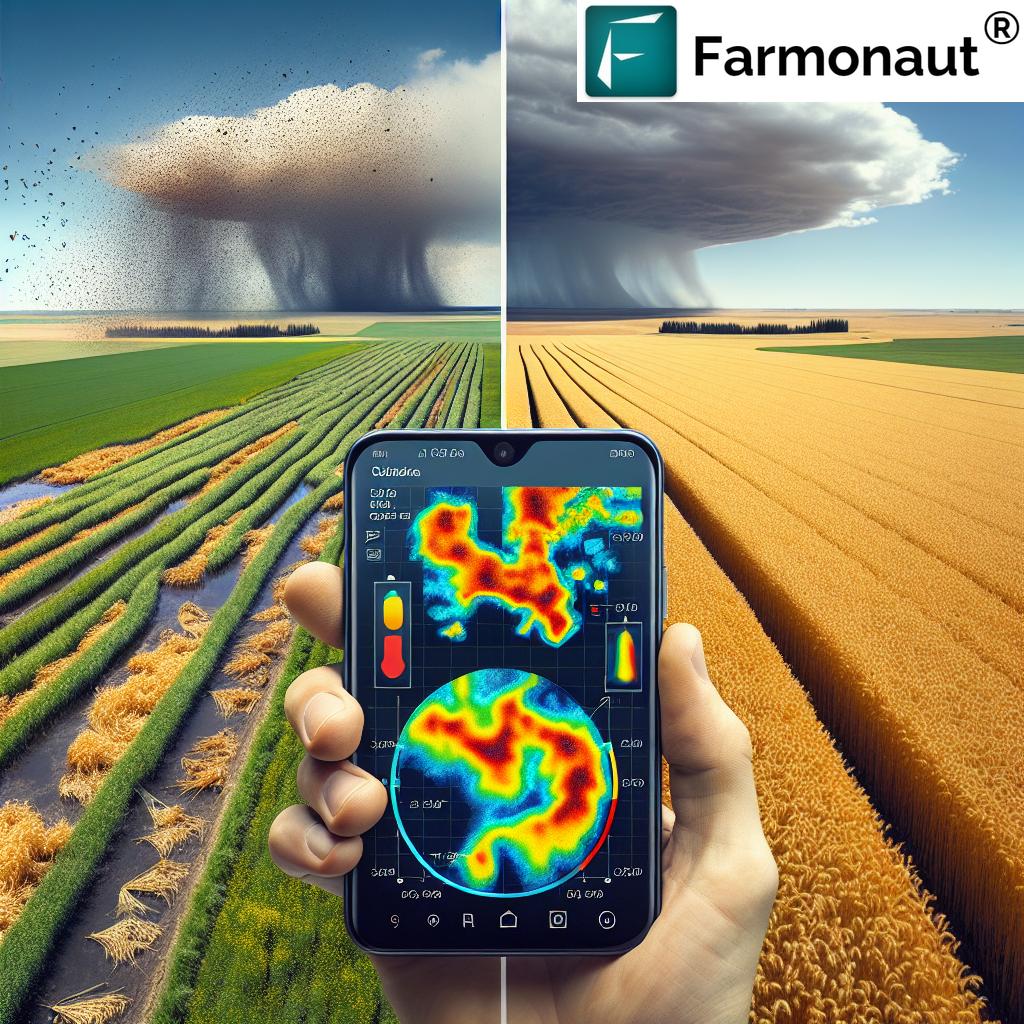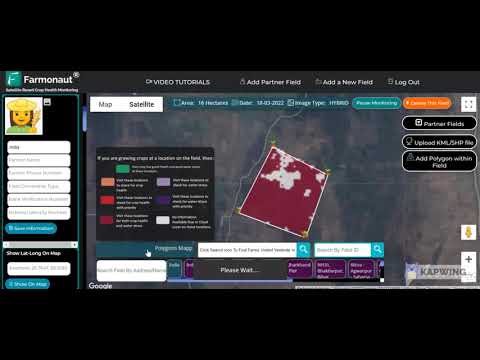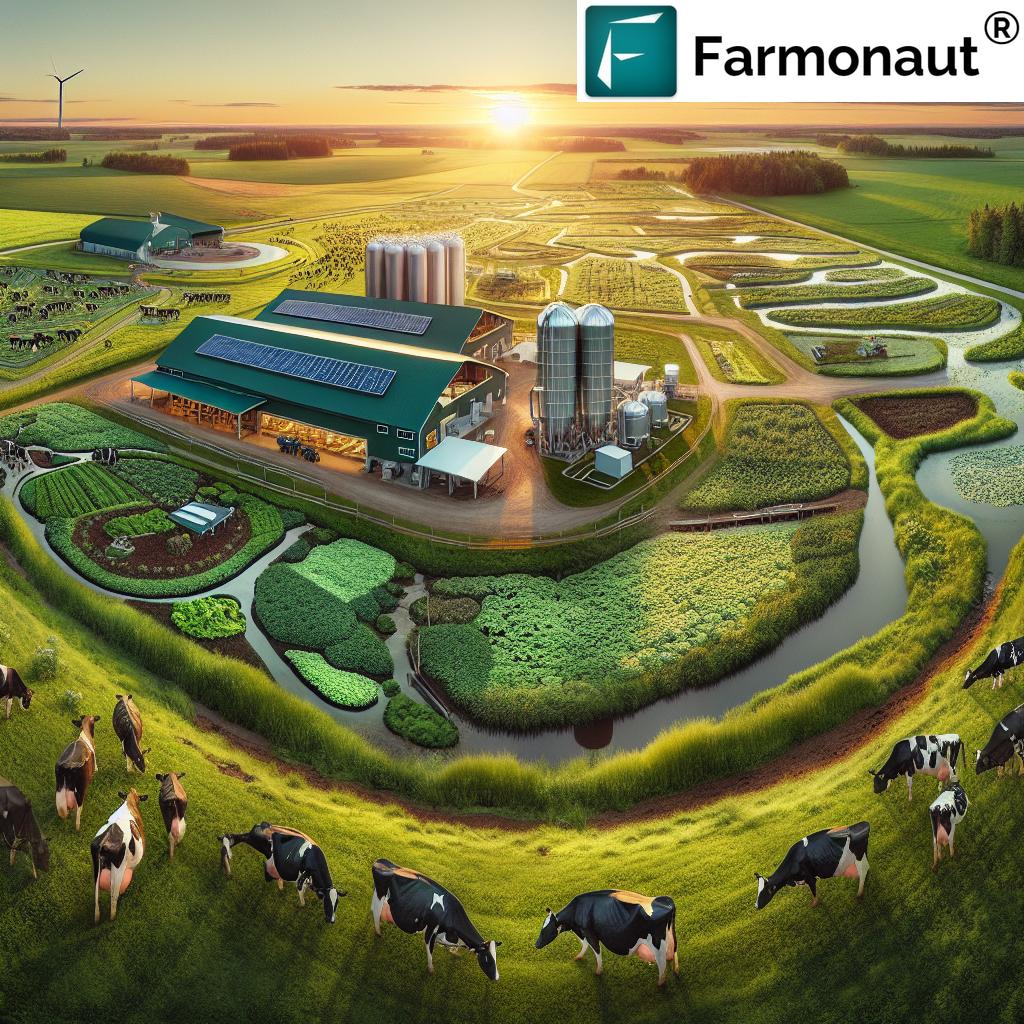Hail Claims in Alberta: How Farmonaut’s Precision Agriculture Tech Can Mitigate Crop Damage Risks
“Saskatchewan accounts for 60% of all hail damage claims in Canada, leading the nation in crop insurance payouts.”
As we delve into the intricate world of Canadian agriculture, we find ourselves facing a season marked by significant challenges and emerging opportunities. The farming landscape this year has been profoundly shaped by crop hail insurance claims and agricultural weather damage, presenting a complex scenario for farmers, insurers, and agricultural technologists alike. In this comprehensive exploration, we at Farmonaut aim to unravel the current state of hail damage across Canadian farmlands, revealing intriguing trends in crop damage claims and farm risk management strategies.
The Current Landscape of Hail Damage in Canadian Agriculture
This season has brought an average number of claims nationwide, but with a twist that’s catching the attention of industry experts and farmers alike. Alberta, known for its vast agricultural expanse, is facing higher-than-usual payouts, highlighting an urgent need for enhanced weather monitoring and smart farming solutions. Meanwhile, Saskatchewan continues to lead the pack, accounting for a staggering 60% of all claims, a figure that aligns with historical data but nonetheless underscores the region’s vulnerability to hail damage.

The impact of these hail events extends beyond immediate crop damage. They’re reshaping how we think about agricultural production challenges and the innovative solutions needed to address them. As we navigate through this blog post, we’ll explore how digital agriculture trends and precision agriculture technology are helping farmers confront these challenges head-on.
Understanding the Hail Claims Landscape
To better grasp the current situation, let’s break down the hail claims data across major Canadian provinces:
| Province | Number of Claims (estimated) | Percentage of Total Claims | Average Payout per Claim (estimated) | Year-over-Year Change (%) |
|---|---|---|---|---|
| Saskatchewan | 12,000 | 60% | $7,500 | +5% |
| Alberta | 5,000 | 25% | $10,000 | +15% |
| Manitoba | 2,000 | 10% | $6,500 | -2% |
| Other Provinces | 1,000 | 5% | $5,500 | 0% |
| National Average | 20,000 | 100% | $8,000 | +6% |
This data paints a clear picture of the challenges facing Canadian farmers, particularly in Saskatchewan and Alberta. The higher-than-usual payouts in Alberta are especially concerning, indicating potentially more severe hail events or increased crop vulnerability in the region.
The Role of Precision Agriculture in Mitigating Hail Damage
In the face of these challenges, precision agriculture technology emerges as a beacon of hope for farmers. At Farmonaut, we’re at the forefront of this technological revolution, offering cutting-edge solutions that can significantly mitigate the risks associated with hail damage and other weather-related challenges.
Our satellite-based farm management solutions provide real-time crop health monitoring, enabling farmers to make informed decisions about their crops’ resilience and health. This proactive approach can be crucial in preparing for and mitigating the impacts of severe weather events like hailstorms.
Key Features of Farmonaut’s Precision Agriculture Technology
- Satellite-Based Crop Health Monitoring: Our advanced satellite imagery provides detailed insights into vegetation health (NDVI) and soil moisture levels, helping farmers optimize their crop management strategies.
- AI-Powered Advisory System: The Jeevn AI system offers personalized farm advice, including weather forecasts and expert crop management strategies, enhancing farmers’ ability to prepare for potential hail events.
- Resource Management Tools: Efficient resource allocation can improve overall crop resilience, making plants better equipped to withstand or recover from hail damage.
“Alberta faces higher-than-average hail damage payouts this season, despite an average number of claims nationwide.”
Climate-Resilient Farming Practices and Their Impact on Hail Claims
The adoption of climate-resilient farming practices is increasingly becoming a necessity rather than an option. These practices not only help in mitigating the immediate impact of hail damage but also contribute to long-term farm sustainability and productivity.

At Farmonaut, we’ve observed a correlation between the adoption of climate-resilient practices and a reduction in the severity of hail damage claims. Farmers leveraging our precision agriculture technology have reported:
- Improved crop resilience to weather extremes
- Better preparedness for severe weather events
- Reduced crop losses in the event of hail damage
Implementing Climate-Resilient Strategies with Farmonaut
Our platform offers several tools that support the implementation of climate-resilient farming strategies:
- Crop Rotation Planning: Utilizing our satellite data and AI insights, farmers can plan optimal crop rotations that enhance soil health and crop resilience.
- Water Management: Our soil moisture monitoring helps in implementing efficient irrigation strategies, crucial for maintaining crop health and resilience.
- Precision Planting: By analyzing historical weather data and crop performance, we help farmers determine the best planting times and varieties to minimize risk.
The Power of Agricultural Data Analytics in Risk Management
In today’s digital age, agricultural data analytics plays a pivotal role in farm risk management. At Farmonaut, we harness the power of big data and advanced analytics to provide farmers with actionable insights that can significantly reduce their vulnerability to hail damage and other weather-related risks.
How Farmonaut’s Data Analytics Enhance Risk Management
- Predictive Modeling: By analyzing historical weather patterns and crop performance data, we help farmers anticipate potential hail risks and prepare accordingly.
- Real-Time Alerts: Our system provides timely alerts about impending severe weather, allowing farmers to take immediate protective actions.
- Post-Event Analysis: After a hail event, our technology assists in quickly assessing damage extent, facilitating faster and more accurate insurance claims.
By leveraging these data-driven insights, farmers can make more informed decisions about crop protection strategies, insurance coverage, and overall farm management practices.
Digital Agriculture Trends Shaping the Future of Farming
As we look to the future, several digital agriculture trends are emerging that promise to revolutionize how farmers approach risk management and crop protection:
- Internet of Things (IoT) in Agriculture: The integration of IoT devices with Farmonaut’s satellite data provides even more granular insights into farm conditions.
- Blockchain for Traceability: Our blockchain-based solutions enhance supply chain transparency, which can be crucial in managing post-hail event crop quality issues.
- Machine Learning for Crop Yield Prediction: Advanced algorithms help in better understanding crop vulnerabilities and potential yields, even in the face of weather challenges.
The Economic Impact of Hail Damage and the Role of Technology
The economic repercussions of hail damage extend far beyond the immediate loss of crops. They affect the entire agricultural ecosystem, from individual farmers to global food supply chains. In Alberta, where we’re seeing higher-than-usual payouts this season, the impact is particularly pronounced.
Breaking Down the Economic Factors
- Direct Crop Losses: The most immediate impact, often leading to significant financial strain on farmers.
- Insurance Premium Increases: Frequent claims can lead to higher premiums, affecting farm profitability in the long term.
- Market Price Fluctuations: Widespread crop damage can influence commodity prices, impacting both farmers and consumers.
- Long-term Productivity Issues: Severe hail damage can affect soil health and future crop yields.
Farmonaut’s technology plays a crucial role in mitigating these economic impacts. By providing early warnings, facilitating quick damage assessments, and offering data-driven insights for recovery strategies, we help farmers minimize losses and bounce back faster from hail events.
Case Study: Saskatchewan’s Hail Challenge
Saskatchewan’s position as the leader in hail damage claims, accounting for 60% of all claims in Canada, presents a unique case study in agricultural risk management. This high percentage isn’t just a statistic; it represents thousands of farmers grappling with the reality of crop loss and financial strain.
Factors Contributing to Saskatchewan’s Vulnerability
- Geographical Location: Saskatchewan’s position makes it particularly susceptible to hail-producing weather systems.
- Crop Types: The predominance of certain crop types that are more vulnerable to hail damage.
- Farm Sizes: Larger farm sizes in Saskatchewan can mean more extensive damage when hail strikes.
At Farmonaut, we’re working closely with Saskatchewan farmers to implement tailored solutions that address these unique challenges. Our satellite-based monitoring and AI-driven insights are helping farmers in the region to:
- Identify high-risk areas within their farms
- Implement targeted crop protection measures
- Make data-driven decisions on crop selection and rotation
- Optimize their insurance coverage based on real-time risk assessments
The Future of Hail Risk Management in Canadian Agriculture
As we look towards the future, the integration of advanced technologies like those offered by Farmonaut will play an increasingly vital role in hail risk management across Canadian farmlands. We anticipate several key developments:
- Hyper-Localized Weather Forecasting: Combining satellite data with ground-based sensors for even more accurate weather predictions.
- AI-Driven Crop Protection Strategies: Advanced algorithms suggesting optimal protective measures based on real-time data.
- Integrated Risk Management Platforms: Seamless integration of weather data, crop health monitoring, and insurance processes.
- Climate Change Adaptation Tools: Long-term planning tools to help farmers adapt to changing weather patterns.
These advancements will not only help in mitigating the immediate impacts of hail damage but also contribute to the long-term sustainability and resilience of Canadian agriculture.
Conclusion: Embracing Technology for a Resilient Agricultural Future
As we’ve explored throughout this blog post, the challenges posed by hail damage in Canadian agriculture, particularly in Alberta and Saskatchewan, are significant. However, the advent of precision agriculture technology, exemplified by Farmonaut’s innovative solutions, offers a path forward.
By embracing these technological advancements, farmers can:
- Better prepare for and mitigate the impacts of hail events
- Make more informed decisions about crop management and risk mitigation
- Improve overall farm productivity and sustainability
- Contribute to a more resilient and efficient agricultural sector
At Farmonaut, we’re committed to continuing our work in developing and refining these technologies, ensuring that Canadian farmers have the tools they need to thrive in an ever-changing agricultural landscape.
For more information on how Farmonaut can help you manage hail risks and optimize your farming operations, explore our range of solutions:

Mobile Apps:


FAQ Section
Q: How does Farmonaut’s technology help in mitigating hail damage risks?
A: Farmonaut’s satellite-based crop monitoring and AI-driven insights provide early warnings, real-time crop health assessments, and data-driven recommendations that help farmers prepare for and respond to potential hail events more effectively.
Q: Can Farmonaut’s solutions be customized for different types of crops?
A: Yes, our technology is adaptable to various crop types and farming conditions, providing tailored insights and recommendations based on specific crop needs and local weather patterns.
Q: How does Farmonaut integrate with existing farm management systems?
A: Farmonaut offers API access, allowing for seamless integration with other farm management tools and systems, enhancing overall farm operations and decision-making processes.
Q: Is Farmonaut’s technology accessible to small-scale farmers?
A: Absolutely. We’ve designed our solutions to be scalable and affordable, making precision agriculture technology accessible to farmers of all sizes.
Q: How often is Farmonaut’s satellite data updated?
A: Our satellite data is updated regularly, with frequency depending on the specific service package. Some data points are updated daily, while others may be updated every few days, ensuring farmers have access to timely and relevant information.

















